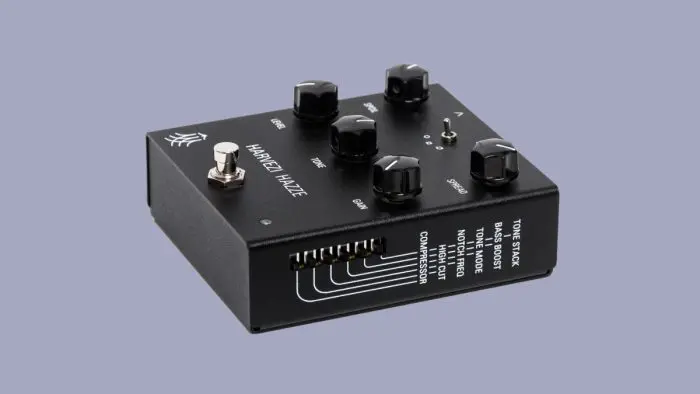SOMA Laboratory has announced its decidedly unconventional distortion pedal that offers both unique distortion qualities and a wide tonal palette of sonic possibilities.
At the heart of the Harvezi Hazze pedal is a waveshaper designed around a unijunction transistor – a relic from the early days of the semiconductor industry unearthed from the e-waste bins of flea markets in Tbilisi, Georgia, the Eastern European country’s largest city.
The unijunction transistor offers unique properties allowing one simple component to replace a number of very complex devices. Therefore. depending on the operating mode, users can access a distortion, a limiter, a waveshaper and a generator – with smooth transitions among each of these.
The name “Harvezi Hazze” translates from Georgian as “a fault on the transmission line” or “signal jamming”, and both the semantic and phonetic nature of these translations imply what users can expect: an impediment to the input signal, which can range from pleasant harmonic distortions to complete obliteration.
The signal chain of Harvezi Hazze consists of an optical compressor with fixed parameters; a dual-mode distorting amplifier with either softer or harsher clipping; a waveshaper built around a unijunction transistor; and a tone stack section designed to tame these sonic building blocks.
Signal flow and controls
Following the input, the signal goes to the Compressor, Distorting Amplifier, Waveshaper, and then to the Tone Stack and output stages. Harvezi Hazze features six control knobs, a three-way switch and a footswitch.
- Gain Control: This controls the output amplitude of the signal in the distorting amplifier section. Depending on the position of the switch, the distortion introduced by this section is soft (with the switch in the left position) or more aggressive with an abundance of high harmonics (with the switch in the middle position).
- Spoil and Spread: This knob controls the operation of the unijunction transistor (waveshaper section). Spoil sets the point on the amplitude axis at which the wave will fold, and Spread sets the amplitude of the folding. The higher the Spread value, the more severe the distortion will be, while Spoil will change the timbre and response threshold. By adjusting Spoil, users can achieve various gating and cutoff effects; at low Spread values, distortion sounds are mixed into the clean sound.
- Tone: This knob adjusts the brightness of the sound. With higher values, higher harmonics become present in the signal.
- Three-way switch. This feature regulates either the distortion mode in the amplifier section (left and center positions), or turns on the total feedback mode (right position) when the values of all knobs begin to influence each other. In this position, effects occur such as resonance at certain frequencies and self-oscillation.
- Level knob: This controls the output volume of the signal.
- Footswitch: This routes the signal through the effect circuitry or from input to output directly (true bypass).
The array of switches on the side of the unit provides even further tonal options; the lower position of the switch enables the specific function:
- Tone Stack: Routes the signal through the tone stack section (Tone knob).
- Bass Boost: Enhances bass frequencies.
- Tone Mode: Changes the behavior of the Tone knob (tilt or lowpass).
- Notch Freq: Changes the central frequency of the filter.
- High Cut: Attenuates high frequencies.
- Compressor: Routes the signal through the compressor.
Harvezi Hazze is priced at €290 EUR.
More information: SOMA Laboratory
 Save up to 95% in Plugin Boutique's Spring Sale!
Save up to 95% in Plugin Boutique's Spring Sale!

